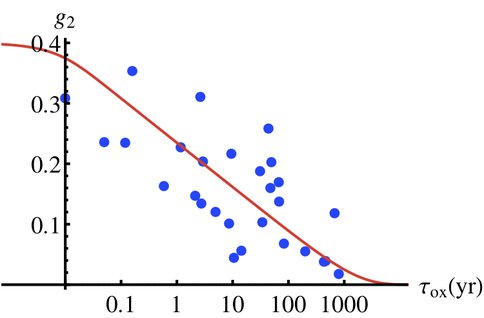2013 Annual Science Report
 Massachusetts Institute of Technology
Reporting | SEP 2012 – AUG 2013
Massachusetts Institute of Technology
Reporting | SEP 2012 – AUG 2013
Neoproterozoic Aerobic Transition
Project Summary
The Proterozoic carbon isotopic record contains evidence of a series of large perturbations to the global carbon cycle, some or all of which may be associated with changes in atmospheric O2. Our team is formulating a theoretical model to explain not only these disruptions but also the permanent increase in O2 levels that occurred by the end of the Proterozoic.
Project Progress
The concentration of free oxygen in Earth’s surface environment represents a balance between the accumulation of O2, due to long-term burial of organic carbon in sediments, and the consumption of O2 by weathering processes and the oxidation of reduced gases. The stability of modern O2 levels is typically attributed to a negative feedback that emerges when the production and consumption fluxes are expressed as a function of O2 concentration. Empirical studies of modern burial of organic carbon suggest that the production of O2 is a logarithmically decreasing function of the duration of time—-the “oxygen exposure time (OET)”—over which sedimentary organic carbon is exposed to O2. The OET hypothesis implies that a fraction of organic matter is physically protected from anaerobic decay by its association with clay-sized mineral surface area, but susceptible to aerobic decay, either oxidatively or via free extracellular hydrolytic enzymes. By assuming that the long-term aerobic degradation is diffusion-limited, we have constructed a mathematical model that predicts the observed logarithmic decrease of the OET curve.
The rise of O2 in the Proterozoic may be associated with the loss of stability of the intial, lower O2 levels. To explain this loss of stability, we propose a positive feedback whereby exposure to O2 enhances not only degradation but also physical protection, due to the precipitation of iron oxides and clay minerals. When the rate of transformation from the unprotected state to the protected state exceeds a small fraction of the average oxidative degradation rate, our theoretical OET curve develops a maximum at small O2 exposure times. In this case, the equilibrium O2 concentration can lose its stability. These observations may help explain major fluctuations in Earth’s carbon cycle and the rise of O2 during the Proterozoic (2000—542 Ma).
-
PROJECT INVESTIGATORS:
-
PROJECT MEMBERS:
Tanja Bosak
Co-Investigator
Dan Rothman
Co-Investigator
-
RELATED OBJECTIVES:
Objective 1.1
Formation and evolution of habitable planets.
Objective 4.1
Earth's early biosphere.
Objective 4.2
Production of complex life.
Objective 5.2
Co-evolution of microbial communities
Objective 6.1
Effects of environmental changes on microbial ecosystems
